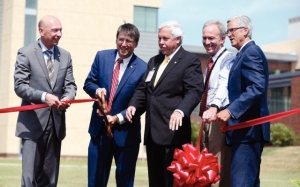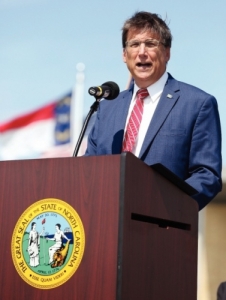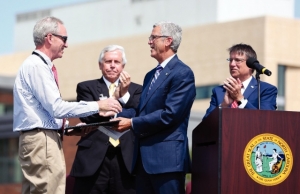Cherry Hospital to open in September
By Steve Herring
Published in News on August 31, 2016 1:46 PM

News-Argus/CASEY MOZINGO
From left, Rick Brajer, Gov. Pat McCrory, Luckey Welsh, Dr. James Mayo and Dale Armstrong ceremoniously cut the ribbon for the new Cherry Hospital Tuesday morning.

News-Argus/CASEY MOZINGO
Gov. Pat McCrory speaks during the dedication ceremony and ribbon cutting for the new Cherry Hospital on Tuesday.

News-Argus/CASEY MOZINGO
Dr. James Mayo receives a plaque from Dale Armstrong during the dedication ceremony and ribbon cutting for Cherry Hospital Tuesday morning.
The new Cherry Hospital will be welcoming patients by the end of September -- some four years past its original planned opening.
But that delay and the problems contributing to it got only a glancing nod Tuesday morning as Gov. Pat McCrory and others focused instead on what the hospital will mean for those suffering from mental health and addiction issues and their families.
Nearly 400 people including local and state elected officials gathered on the hospital campus on West Ash Street for a ribbon-cutting and dedication ceremony for the $138 million facility.
Dr. Jim Mayo, the hospital's clinical director, was recognized for his years of service by Dale Armstrong, deputy secretary for the Department of Health and Human Services facility based behavioral health and development services.
Armstrong announced that the hospital's adolescent services unit has been named in Mayo's honor.
The speakers shared a similar theme of removing the stigma often attached to people suffering from mental health issues and that the new hospital, while impressive, is just another tool in their treatment.
"I have a personal philosophy that we as a society, and it is a philosophy in this government, that we must take care of those who can't take care of themselves while encouraging those who can," McCrory said. "This building behind us, and the people working in this building, are doing just that. We are helping those who can't take care of themselves, but we also are encouraging those who can.
"Our goal is to have this to be a temporary stay for those dealing with mental health or addiction issues. Our goal is to get them back into the life of their family, neighborhood and work and become productive citizens and to be a part of their family again in any way that we can."
Much has been learned over the past 20 years about mental health and treatments, he said.
"But the most important thing is that we are going to treat these people with dignity and humanity because they deserve it," McCrory said.
The hospital is also good for the area because of 373 new jobs, but that is not the reason that it was built, he said.
"It is not about job creation," McCrory said. "It is helping those return to society and deal with own individual issues. This is the best of North Carolina."
A lot has changed since the original Cherry Hospital was built more than 100 years ago, McCrory said.
For one thing the hospital was once known as a hospital for the insane, he said.
"Now that we have become more educated on mental health we realize these are people dealing with issues that all of us are having to deal with," McCrory said. "They are members of our family. They are our neighbors, and they are our friends."
While the patients will not move into the new hospital until late September, the staff has been busy training, hospital CEO Luckey Welsh told the News-Argus.
"We have been training and moving because, keep in mind, on the first day that we take these patients in here we have got to provide good, safe care to them," he said. "So we have been doing drills and making sure that we can respond to any emergencies so at the end of that day when they come in here they will be safe. That is our job."
The hospital currently has around 1,100 employees, but will add another 300 over the next year and increases the current number of beds from 197 to 313.
"We are the safety net," Welsh said. "As I have said to others, most patients are cared for in the community, but when those needs cannot be met they come to us. That is what we are here for. We are not in the business to try and grow.
"We are in the business that we hope they care for them in the community. But should they need the care, they come to us. That is what we are here for."
Rick Brajer, secretary of the Department of Health and Human Services, said that not only is Cherry Hospital devoted to hope, care and recovery, but that he also sees joy, love and relationships between the people who work at the facility and the patients who are served.
"The new building is important, but it just another tool in a broader array of services to help the state address the complex behavioral health issues," he said.
Brajer said he wanted to follow up on McCrory's comments about removing the stigma of mental health issues.
"The reality is, I don't know, there might be 300 people gathered here today, and there is a simple reality which is 20 percent of us are dealing with at this time with a mental health disorder," he said. "We are either dealing with anxiety, or depression, or bipolar or suicide ideation (thoughts), whatever challenges we might have.
"We are not talking about the folks in that building. We are talking about us right now. Just as all of us have physical health at any given time, we are either well or we are well -- all of us have mental health. At any given time we are either ill or we are well. But so often we get quiet when we talk about mental health and mental illness in a way that we don't with physical health and physical illness."
It would be awesome if all of the problems could be fixed by building the new hospital and increasing capacity, Brajer said.
That is important, but he said people need to think about the hospital in terms of a broader array of services needed to systematically address behavioral health needs.
Addressing legislators, Brajer said they are being depended on to partner with the department and to provide leadership and support to make that happen.
"There is a whole breadth of community-based services that we need for addressing the vast problem that exists outside of this facility," he said
There are nearly 20 building on the old campus, including four that house patients, Welsh said following the ceremony.
"We are going to maintain about three of the buildings there -- an administrative building, a conference center and a warehouse," Welsh told the News-Argus.
"But all of the patient care buildings, we will be moving out of those and will be turning them over to the Department of Administration eventually after we finally vacate all of the furniture out of there. It will be up to them with what happens to the campus."
One major difference between the old and new hospitals is that all service especially medical service, like laboratory services, radiology services, cardiac monitoring services, is under one roof, Brajer told the News-Argus.
"What happens right now, if you will at old Cherry Hospital, is that it is across different parts of the campus," he said. "They literally have to transport patients from one area to another which can be really stressful for the patients.
"This makes it much more natural. It is almost like a mall concept where you can get services in one area and other services in other areas."
The increased capacity allows the state to unburden regional hospitals that don't have the skills or the capacity for serving the people with the greatest of mental health needs, he said.
